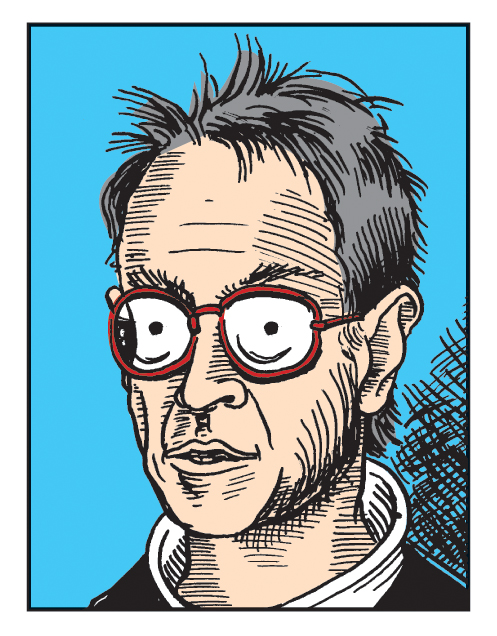Graphic Novels & Comics
A look at Graphic Novels, Memoirs and Comics by writers from Mennonite contexts--both professionals and college students, guest edited by Jessica Baldanzi and Mary Roth.
In this issue:
-
0
read more

Introduction
by Jessica BaldanziComics and graphic novels have long had to battle for respect and legitimacy, at least in the U.S. Whenever the genre pops up in the news, reporters still register surprise in headlines that comics are "not just for kids anymore" and "not just about men in tights."
Yet it was almost twenty-five years ago, in 1992, that Art Spiegelman's Maus became the first graphic novel to win the Pulitzer Prize. While far from the first serious story to be told in this medium, it was the first time that the literary establishment in the U.S. acknowledged what the genre could …
-
0
read more
Holy Comics!
by Sabrina JonesAdapting the gospels for a graphic novel called Radical Jesus was a dream project for me. In doing so, I entered a field where many had gone before, but few of whom I admired.
After a dozen years in a Quaker bible study group, and about twice as long writing and illustrating comics on issues of social justice, I was enchanted at the prospect of merging these previously disparate sides of my life. Editor Paul Buhle, a veteran activist and historian of American radicalism, had led me to create comics on visionaries like John Reed, Big Bill Haywood, Mabel Dodge, …
-
0
read more

A Simple Ordinary Man
by Gary Dumm and Scott MacGregorLet's get something straight right now at the beginning of the story; Benjamin Braxton Beltran was NOT a simple, ordinary man. He was, in fact, a very complex and extraordinary man. It's ironic that the city of Cleveland, Ohio—a town forever flirting with true greatness—had failed so badly to recognize the greatest Clevelander it ever had, when it had him.
The yin-yang of Cleveland centers around water and always will. It's not just the quality of it; it's what living near the lake does to Clevelanders. Water is an omnipresent force. We are mainly made of it and so the …
-
0
read more

A Simple Ordinary Man - Commentary
by Scott MacGregorSeventeen thousand years ago, in what is now southwestern France, a hunter/gatherer (we’ll call him Thak), had run ahead of his hunting partner anxious to be first with good news from the hunt. Thak had many stories to tell, but was unable to put his observations into words since language, as we know it today, had not been invented yet. It was a lucky thing for everyone that Thak was gifted with a talent that set himself apart from the rest of his Paleolithic clan. Thak was able to draw pictures.
By deriving oily pigments from minerals and plants and …
-
0
read more

Radical Jesus Commentary
by Paul BuhleWhat makes Nick Thorkelson’s work, the final section of Radical Jesus, so powerful visually as well as narratively?
The unique quality of the final section is its basis in oral history. As a founder of the Oral History of the American Left at New York University in 1975, and as an oral history fieldworker and teacher from labor history to the story of the Hollywood Blacklistees, I learned to trust (and encourage my students to trust) "the story." Interviews with ordinary or extraordinary people possess an "orality" unique to themselves, their own life understanding. This is not …
-
0
read more
Fantastic Theological Anthropology: Milton, Gaiman, and the Anabaptists
by Jeremy Garber"Others apart sat on a hill retired, / In thoughts more elevate, and reasoned high / Of Providence, Foreknowledge, Will and Fate-- / Fixed fate, free will, foreknowledge absolute-- / And found no end, in wandering mazes lost." – Milton,Paradise Lost,2: 557-561
Introduction
Anyone who has attended a theological symposium finds the image of devils in Hell debating arcane points of theology unfortunately resonant. The two texts under consideration in this essay reflect – and in Milton's case, have shaped – Western conceptions of what humans are, how they think, love and create, and whether there is an …
-
0
read more
Cloning Enchantment: Jesuses After Climate Change
by Elizabeth CoodyWhen I found one comic with a Jesus that scientists had cloned from relics, I chuckled at its clever premise. When I found the third Jesus Clone comic, I realized that something had to be going on. As a biblical scholar with professional interests in comics, I had come upon one of those ideas that will not let me go.[1]
I find that Jesus Clone reflects an anxiety about human control and biblical promises in a underexplored corner of U.S. popular culture. There are other thinkers who linger over questions about the worth of popular culture and comics in addressing …
-
0
read more

Martin Luther King and the Montgomery Story
by Anne Berry and Regina Shands Stoltzfus**Transcript has been edited for print**
Link to comic:http://www.crmvet.org/docs/ms_for_comic.pdf
Link to podcast:https://drive.google.com/file/d/0B1ewKUsxqFV5cF9EWmRaWVBuNnM/view?usp=sharing
Jessica
Hello. Welcome. My name is Jessica Baldanzi and I’m here for a special issue on graphic novels and comics for the Journal for the Center of Mennonite Writing. I am an associate professor of English here at Goshen College and I’m here with two awesome guests to talk about the comic book Martin Luther King and the Montgomery Story. Would you like to introduce yourselves?
Regina
Hi, I’m Regina Shands Stoltzfus. I also teach at Goshen College in the Peace Justice Conflict Studies department, …
-
0
read more

When Life Hands You Lemons, Check For Lymes - Commentary
by Phil GerigscottI picked up comic-making in elementary school, beginning with a Calvin and Hobbes-inspired "Mikey" series, Captain Underpants fan fiction, and a graphic novel series based on my pet anole lizards. By high school, I was still drawing comics, but they mostly took the form of inside jokes drawn on the backsides of homework assignments.
While studying art education at Goshen College, however, I began submitting weekly comics under the name "B-fast Gigz" to the school’s paper. In 2014, I self-published my first two comic books, "B-fast Gigz: An Eclectic Collection" and "Dumbsters," for my senior art show. The summer …
-
0
read more

When Life Hands You Lemons, Check For Lymes
by Phil GerigscottThis occurred while camping on North Manitou Island off the coast of Michigan. I later learned that burning ticks causes them to vomit their bacteria into the blood stream. I also learned a little too late that North Manitou has explosive Lyme rates. Hindsight, gotta love it.
As depicted in the book, I actually went to the doctor immediately after I was bitten by the tick. He gave me a precautionary pill and sent me on my way. Because of this blind trust, when my knees started bothering …
-
0
read more

Sketches
by Jim Strouse -
0
read more

A Tribute to Joel Kauffman
by Ann HostetlerA survey of Mennonite cartoonists would not be complete without a tribute to Joel Kauffmann, creator of Pontius’ Puddle. The first cartoonist whose work appeared regularly in Mennonite publications, Kauffmann was a pioneer in introducing humor into religious magazines.
When Kauffmann announced in early 2015 that he would no longer write new cartoons for the series, Pontius’ Puddle had had a more than 30-year run in over 200 periodicals. The cartoons are still available from www.pontius.com, a site run by his son Justin Kauffmann.
Growing up in a Mennonite minister’s family in Hopedale, Illinois, Kauffmann got his start by …
-
0
read more

Introduction to Student and Former Student Works
by Mary RothThe next section profiles the work of four current and former students of English 235: The Graphic Novel, a class taught by Jessica Baldanzi at Goshen College. I also completed the class—six years ago as a shy first-year—and as I worked on this issue with Jessica, I was delighted to revisit some of the concepts and texts that we had covered. I remember the wonder I felt in reading Alison Bechdel's Fun Home for the first time; the important conversations about religious and cultural representation that emerged from Art Spiegelman's Maus; and the delight in creating my own …
-
0
read more

All Things Grow
by Mary Roth -
0
read more

A Little About Me
by Samantha Horsch -
0
read more

A Little About Me - Commentary
by Samantha HorschMy project shows a simple, yet unique style of art that borrows some elements of Japanese comics, or manga. Lack of gutter space, or spaces between panels, is one of the biggest influences I’ve picked up from reading manga. More American-style panels and gutters feel to me like a lot of boxed in scenes.
I also borrowed some iconic symbols from manga. American comics readers might be used to a light bulb over a character’s head, for example, to show a good idea, while manga readers have a whole different set of symbols that might not make sense to …
-
0
read more

Alone
by Amanda Vanderzee -
0
read more

Alone - Commentary
by Amanda VanderzeeAs a kid up I read Archie and Betty & Veronica comics on the floor in my bathroom, as a teenager I sat in the bookstore for hours reading Japanese comic books called manga,and as an adult I have moved onto reading comic books such as Papergirls and The Amazing Spider-Man, as well as graphic novels like Solanin and My Friend Dahmer. I’ve always loved to read, and I’ve been fortunate to have parents who both had the means to provide me with plenty of reading material, and who never tried to dictate what I read, whether …
-
0
read more

The Accident
by Grace Weaver -
0
read more

The Accident - Commentary
by Grace WeaverAlthough comics aren’t just for kids, they’re an excellent way to tell a grown-up story from a child’s perspective. My short graphic memoir, "The Accident," shows and tells the story of how I lost three of my front teeth as a four-year-old—a traumatic event of which I remember very little. I’ve pieced together enough snapshot memories and retellings from my family to create a cohesive narrative, although I have to admit that a few details are invented.
This story, told from the perspective of a child, fits so well into the graphic novel and comics genre because of the very …
-
0
read more

36/19
by Sarah Rich -
0
read more

36/19 - Commentary
by Sarah RichWhether or not they know it, all Americans are characters in the story of July 19, 1979—and of what happened in Nicaragua in the decade that followed.
Unfortunately, in this particular story we feature more as villains than heroes, which is probably why this narrative has managed to stay on the margins of our consciousness. I wasn't even born yet in 1979, and I had never heard this story until I signed up to volunteer as an English teacher in a rural Nicaraguan village for two years. So it was a bit embarrassing when my new Nicaraguan friends had to …